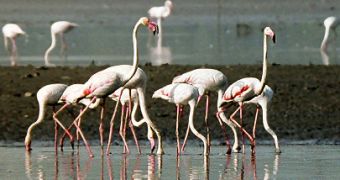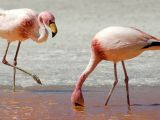1. Flamingos are gorgeous birds that might have inspired the legend of the Phoenix Bird because of their bright plumage. They are distantly related to herons and pelicans. Today, only five species classified in one single family survive. Five fossil families of flamingos are known, that comprised birds of various sizes. Amongst the fossil genera are Elornis and Tilornis.
The existence of the modern genus Phoenicopterus is known from the Lower Miocene, 23 Ma ago. Five flamingo species became extinct 10,000 years ago.
Because their beak resembles the one that ducks also have and due to the fact that they share a few parasites with these birds, flamingos were thought to be related to geese and ducks, but proteins, DNA, skeleton, voice and digestive system point that the real kinship is in fact with herons.
The largest flamingo is the Greater Flamingo (Pheonicopterus ruber) from the Old World. The bird is up to 1.6 m (5.3 ft) long, and has a wingspan of 1.65 m (5.4 ft) and a weight of 3.5 kg (8 pounds). The smallest flamingo is the James flamingo (P jamesi), inhabiting the Andean puna lakes, at altitudes of 4,000-4,700 meters (13,300-15,600 ft). The bird is 90 cm (3 ft) long, weighing 2 kg (4.4 pounds).
2. Unlike other birds, the flamingos have a much larger lower jaw than upper jaw. The massive bill is bent in a right angle. The newly hatched flamingos have a straight bill.
These are the only birds to hold the tip of the bill backwards while feeding. Flamingos search for food only in shallow waters: they introduce their beak into water, tilted upside down, and move their heads from side-to-side. When feeding, the tongue of the bird works like a pump, sucking in water and mud through the front side of the bill, squeezing them with side filters on the lower jaw at a rhythm of 20 to 240 times per minute, in a come-and-go type of movement.
The lower jaw is made from erectile tissue. Large oval masses of erectile tissue make the mouth floor on the sides of the tongue. When the erectile tissues fill with blood, they stiffen, strengthening and supporting the floor of the mouth and the tongue; the same effect causes erections in a man's penis. Nevertheless, the flamingo's erectile tissue confers stability, as the birds remain with their heads upside down underwater to suck up food.
Fringed plates on their tongues trap the food that is made of small crustaceans, worms, larvae and algae. The red color is given by the carotene that comes from the food; when this chemical is scarce in the food a flamingo ingests, its feathers turn pink and even white.
3. Like penguins and pelicans, the flamingos form nurseries: when adults go to feed, the young are guarded by several adults. Juvenile flamingos are gray, young flamingos are white and, by the age of 3, they are pink. The young are fed with a type of creamy red "milk" secreted by the stomach of the adults. Flamingos form huge colonies, and the conical mud or sand nests can measure 50 cm (1.6 ft) tall, with a base diameter of 60 cm (2 ft).
4. These birds live up to 35 years in the wild and 50 in captivity.
5. At their extravagant banquets, Romans served flamingos boiled with dates.

 14 DAY TRIAL //
14 DAY TRIAL // 
